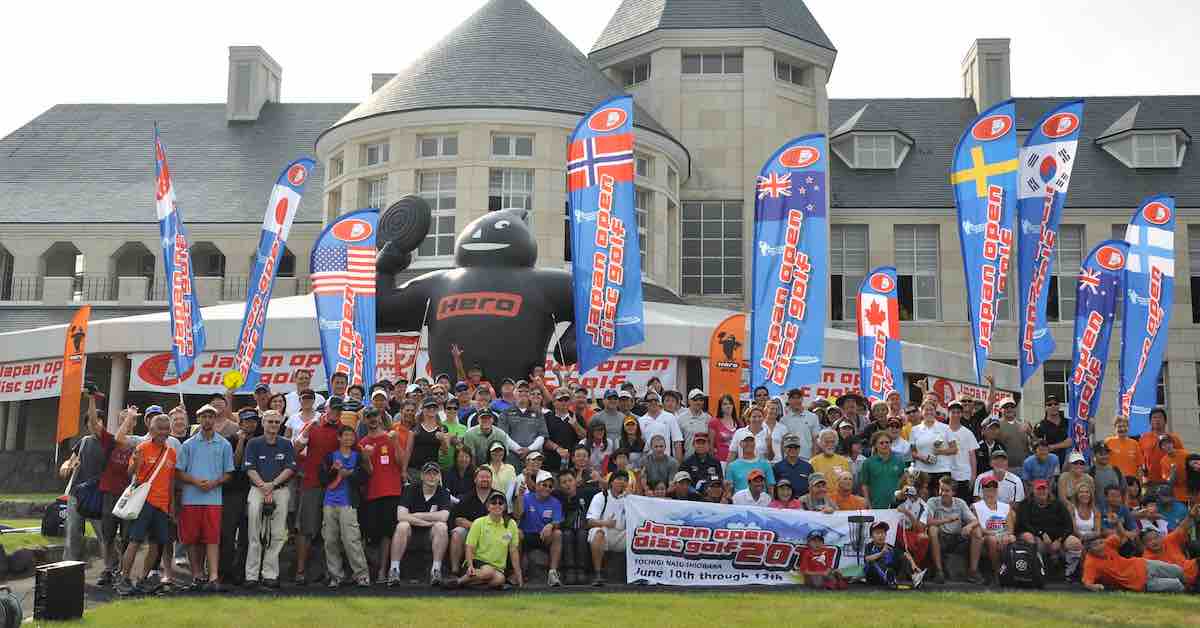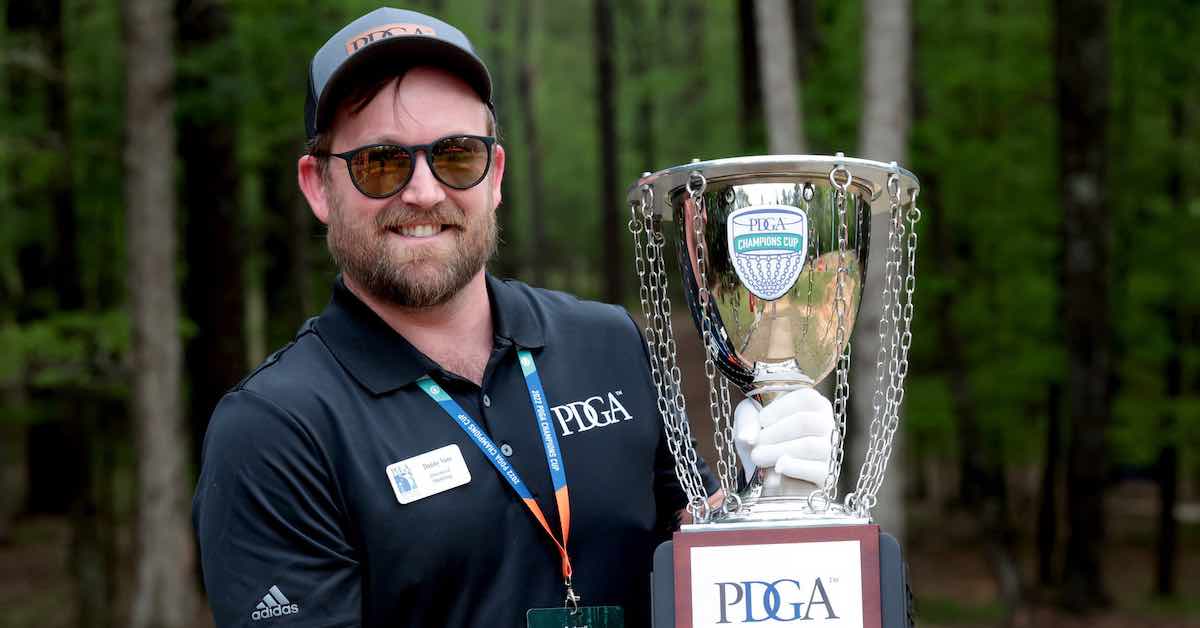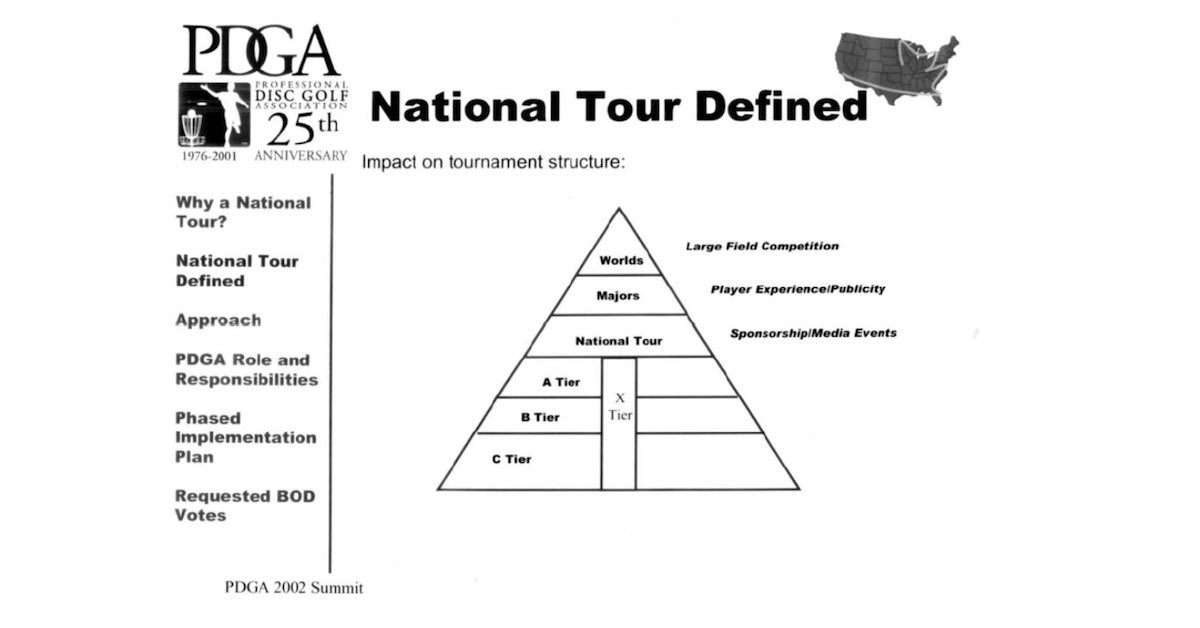So far there have been 105 disc golf Majors with an Open division (also called MPO, which stands for Mixed Professional Open) and 35 different players have claimed victories at one or more of them.
If you want to know who any of those competitors are and what event(s) they won, you've come to the right place. We've also got interesting stats related to Majors as well as insights into the history and development of this elite event tier.
Here's what you'll find – in order – in the rest of this post:
- All MPO winners at disc golf Majors in a chronological and color-coded table
- Which players have won the most disc golf Majors in MPO
- Stats related to MPO winner earnings at disc golf Majors
- The number of times every disc golf Major with an MPO field has been played
- Where to find disc golf Major stats for FPO
- The history and purposes of disc golf Majors

Disc Golf Majors: All Winners (MPO)
| Year | PDGA Worlds | U.S. Disc Golf Championship |
European Open | Champions Cup | Japan Open | Other: European | Other |
| 2025 | Buhr | Barela | Robinson | Heimburg Euro. Disc Golf Fest. |
|||
| 2024 | Robinson | Buhr | Buhr | Presnell | |||
| 2023 | Robinson | Klein | Ellis | Robinson | |||
| 2022 | McBeth | Buhr | McMahon | Dickerson | |||
| 2021 | Conrad | McBeth | |||||
| 2020 | Dickerson | ||||||
| 2019 | McBeth | Conrad | McBeth | ||||
| 2018 | Barsby | McBeth | McMahon Konopiste Open |
||||
| 2017 | Wysocki | Sexton | McBeth | Wysocki Aussie Open |
|||
| 2016 | Wysocki | Koling | Wysocki European Masters |
||||
| 2015 | McBeth | McBeth | McBeth | McBeth Scandinavian Open |
McBeth Aussie Open |
||
| 2014 | McBeth | Schusterick | Wysocki | McBeth European Masters |
|||
| 2013 | McBeth | Brinster | McBeth | McBeth Copenhagen Open |
|||
| 2012 | McBeth | Schusterick | Schusterick Stockholm Open |
||||
| 2011 | Doss | Feldberg | Wysocki PDGA Championship |
||||
| 2010 | McCabe | Schusterick | Locastro | Feldberg Scandinavian Open |
|||
| 2009 | Jenkins | Locastro | Lundmark | ||||
| 2008 | Feldberg | Doss | Feldberg | Lundmark Scandinavian Open |
McCabe The Players Cup |
||
| 2007 | Doss | Climo | Climo | Feldberg The Players Cup |
|||
| 2006 | Climo | Schultz | Feldberg | Rico | Jenkins The Players Cup |
||
| 2005 | Doss | Feldberg | |||||
| 2004 | Schultz | Climo | Jenkins | ||||
| 2003 | Schultz | Schultz | |||||
| 2002 | Climo | Climo | Rico | ||||
| 2001 | Todd | Schultz | |||||
| 2000 | Climo | Climo | |||||
| 1999 | Russell | Climo | |||||
| 1998 | Climo | ||||||
| 1997 | Climo | ||||||
| 1996 | Climo | ||||||
| 1995 | Climo | ||||||
| 1994 | Climo | ||||||
| 1993 | Climo | ||||||
| 1992 | Climo | ||||||
| 1991 | Climo | ||||||
| 1990 | Climo | ||||||
| 1989 | Wisecup | ||||||
| 1988 | Ahart | ||||||
| 1987 | Hosfeld | ||||||
| 1986 | Sias | ||||||
| 1985 | Duvall | ||||||
| 1984 | Ferrans | ||||||
| 1983 | Watson | ||||||
| 1982 | Duvall |
Who Has Won the Most Disc Golf Majors?
Ken Climo, who no longer tours, won 18 PDGA Major tournaments in MPO, which is the most of any player in the sport's history. Paul McBeth has 17 PDGA Major titles in MPO and is the closest active player to Climo's mark.
For a look at how many titles every Major winner has, see the table below (on mobile, swipe left/right to see all columns):
| NUMBER OF DISC GOLF MAJOR WINS IN OPEN DIVISION |
|||||
| 10+ |
5-9 |
4 |
3 |
2 |
1 |
| Ken Climo (18) Paul McBeth (17) |
David Feldberg (7) Ricky Wysocki (6) Barry Schultz (5) |
Gannon Buhr Nate Doss Isaac Robinson Will Schusterick |
Avery Jenkins |
James Conrad Chris Dickerson Harold Duvall Nikko Locastro Jesper Lundmark Eric McCabe Eagle McMahon Steve Rico |
John Ahart Anthony Barela Gregg Barsby Steve Brinster Corey Ellis Sam Ferrans Calvin Heimburg Gregg Hosfeld Kyle Klein Jeremy Koling Andrew Presnell Ron Russell Nate Sexton Johnny Sias Cam Todd Jeff Watson Steve Wisecup |
MPO Winner Earnings at Disc Golf Majors
These are some of the most interesting facts about what competitors have earned for winning Open at Majors:
- Total payout to MPO winners at Majors
Collectively, MPO winners have taken home $837,703 from all Majors. The inflation-adjusted buying power of those winnings is about $1,163,603. - Average payout for MPO winners at Majors
Over 105 events, MPO champions have earned on average $8,216 for a Major win. All totals adjusted for inflation, the number goes to about $11,082. - Which MPO competitor has earned the most from winning Majors?
Paul McBeth's $127,895 in payouts for winning Majors is the most in history. Adjusted for inflation, McBeth's $162,467 in modern buying power is more than Climo's inflation-adjusted $155,615 ($84,995 unadjusted).
How Many Different Events Have Been Pro Disc Golf Majors?
Events of 14 different names have been Majors with an MPO division. Below you can find each of them in order of the frequency they've occurred as Major competitions (number of iterations in parentheses):
- PDGA Disc Golf World Championships (43)
- U.S. Disc Golf Championship (26)
- European Disc Golf Festival (1)
- European Open (11)
- Japan Open (6)
- PDGA Champions Cup (4)
- The Player's Cup (3)
- Scandinavian Open (3)
- Aussie Open (2)
- European Masters (2)
- Copenhagen Open (1)
- Konopiste Open (1)
- PDGA Championship (1)
- Stockholm Open (1)
Note that some events (e.g., pre-1999 Japan Opens) have taken place without being classified as Majors. Those iterations aren't included in the above totals.
Where Can I Find Disc Golf Major Stats for FPO?
Head on over to our post "All Open Women Disc Golf Major Winners."
What Is a Disc Golf Major?
The highest of the Professional Disc Golf Association's event tiers, Majors are competitions that, as current PDGA Events Manager Michael Downes told us, "punctuate the history of the sport, elevate a player's legacy, and settle debates about which golfers are better than others in the all-time conversations."
But how did Majors become such milestones in disc golf? In the sections below we explore the development of the Professional Major tier and the evolution of its meaning.
Origins of Disc Golf Event Tiers
According to Brian Hoeniger, the PDGA formalized and began classifying events as – listed respectively in order of importance – A, B, and C tiers in 1994 when he was the board member entrusted with this task. At that point, events that had been called SuperTours since the late 1980s became A tiers. Hoeniger is the organization's current International Director but has also served as Executive Director and Administrator during his over quarter-century with disc golf's governing body.
The year 1994 is significant because it was the first time results of PDGA-sanctioned disc golf competitions were recorded with computers.
"Prior to that everything was handwritten and there was a monthly or bi-monthly newsletter [with tournament results]," Hoeniger explained. "There was no database or anything."
The tiers helped organize the newly digitally recorded tournament information, but there didn't seem to be a need for anything more than the ABC tier set. The only event that clearly stood out over A tiers was the PDGA Disc Golf World Championships (often called simply "Worlds") for which players qualified on the basis of tour points. But as disc golf competition advanced and other standout tournaments emerged, the need for a higher tier became apparent.
That tier emerged in 2002.
"2002 was an important year when volunteers at the time, Steve Ganz and Jason Haas, were coding the online event calendar and tournament results displays for the PDGA website," wrote Chuck Kennedy, co-inventor of the PDGA ratings system, in a comment to a request for information about the history of Majors in the Disc Golf History Facebook group. "They asked for guidance on the codes that should be applied to indicate which events were at a certain sanctioning tier. Theo Pozzy, Roger Smith, and I had just gotten Board approval in early 2002 under Pat Govang and Brian Hoeniger's leadership to implement the rating system as a PDGA benefit. So all these things converged during 2002 when the M code was used to indicate Majors."
Hoeniger verified Kennedy's statement, and Pat Govang, PDGA Commisioner 2000-2003, provided a visual from "the 2002 summit/board meeting where the Majors (along with NTs [National Tour events]) were formally recognized as a tier of events."
Two tiers you can see in the pyramid above no longer exist: Worlds and National Tour. Worlds is now classified simply as a Major and the National Tour ended its run at the end of 2021 after the Disc Golf Pro Tour and PDGA struck a deal to work together closely on professional events.
What Makes a Disc Golf Major a Major?
Like a lot of disc golf vocabulary, "Major" is a term associated with traditional golf. The four most prestigious traditional golf events – the Masters, PGA Championship, U.S. Open, and Open Championship – are called Majors. Comments from Kennedy suggest that select competitions became pro disc golf Majors when the PDGA saw it as logical or prudent to give them elite standing.
"In terms of a standard for future events becoming Majors, it happened organically when new events were suggested or planned that the PDGA Admin and Competition Committee agreed should get Major status even if they weren't going to start out as Major-like events in terms of field size or purse," Kennedy wrote.
Kennedy pointed to the U.S. Women's Disc Golf Championship (USWDGC) as an event that was awarded Major status before its attendance or payout levels were particularly overwhelming. Though Kennedy didn't say it outright, the logical inference here is that the PDGA wanted to show its support of this event by naming it a Major, hoping the designation would help draw big fields and top competitors. The USWDGC was first held in 2001.
Those looking for exact standards for Majors will be disappointed. The most concrete thing that defines them currently is the requirement that purses total a minimum 125% of net entry fees. Other than that, the PDGA states that "length, purse, number of holes, and many other elements of these prestigious events are handled on a case-by-case basis" while also making it clear that only teams with extensive experience putting on large sporting events can host one.

Mostly, it seems, what defines Majors is a social contract among those in the disc golf community – administrators, players, fans, and media – to treat them as the sport's premier events.
What Are the Purposes of Disc Golf Majors?
Majors serve a variety of purposes in pro disc golf.
Downes told us that Majors should "bring together the best disc golfers in the world in competition and fellowship" and provide players the opportunity for "vast media exposure." He also said that winning a Major should give a competitor an "overwhelming sense of pride, joy and accomplishment knowing they just beat the best players in the world."

Along with offering participants a special experience and chances for career-defining and career-launching performances, Downes indicated that professional Majors should demonstrate in a big way the positive impacts hosting competitive disc golf can have on communities. Host cities and towns see an immediate economic impact from players, spectators, and media booking hotels, dining in local restaurants, shopping, and so on. With the rise in pro disc golf viewership via online outlets, it's also now to be expected that hosting a pro Major will bring an uptick in disc golf tourism following an event as people get interested in playing the courses they've watched their favorite pros take on.
Finally, Downes sees Majors as a way to help disc golf grow worldwide.
"PDGA Majors offer an opportunity to increase disc golf's exposure and development throughout the world while allowing new generations of disc golfers to experience a premier competition experience," Downes said.
The Future of Disc Golf Majors
PDGA leadership – including Nate Heinold, the chair of its Major and Elite Series Committee – indicated they wanted a standard of four Majors per year in 2022 and have stuck to that. The total mimics the four Majors in traditional golf.
The only Major that has stayed in the same location since 2022 is the USDGC in Rock Hill, which only offers an MPO division.

The World Championships and the U.S. Women's Disc Golf Championship have always been roving Majors hosted in different places. The Champions Cup was meant to stay at the International Disc Golf Center in Georgia on the W.R. Jackson course, but a southern pine beetle infestation followed by a destructive hurricane disrupted those plans, and the event was held in Morton, Illinois, in 2024 and Stockton, California, in 2025.
The European Open was held in Nokia, Finland, from 2022-2024, but the city (along with neighboring Tampere) became the first place outside of North America to host Worlds in 2025. That meant Europe's other Major needed to move elsewhere, and it landed in Tallinn, Estonia, at the European Disc Golf Festival. The PDGA has announced already that Tallinn will host Majors again in 2026 and 2028 as well as in 2029 when it will become the second European location to host Worlds.
Disc Golf Tournaments Retroactively Named Majors
Though the Major tier was only invented in 2002, the PDGA has opted to retroactively classify some events as Majors. Those that had pro divisions include:
- All PDGA Disc Golf World Championships prior to 2002
- All USDGCs prior to 2002 (1999, 2000, and 2001)
- The 1999 Women's National Championship
- The 2000 Women's National Disc Golf Championship
- The 2001 USWDGC
Nerd Out Even More About Disc Golf's Biggest Events
If you enjoyed this post, we have similar ones devoted to the two longest-running pro Majors. Check out the winners, runners-up, and who has the most top 10s at both Worlds and the USDGC.
Don't want to miss it when we put out more content like this? Subscribe to our 'Release Point' newsletter.
Note: Publication date reflects the last update to this post following the most recent Major.

